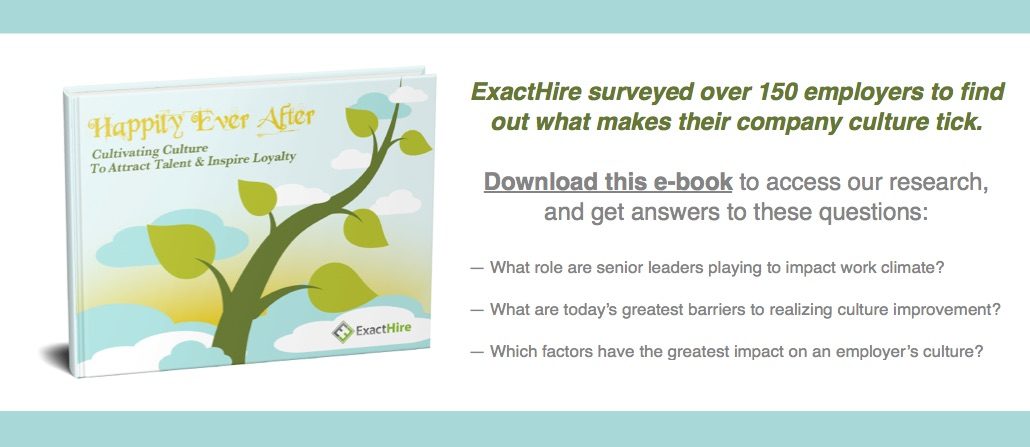How to Motivate Management to Support Company Culture Improvement
Hopefully you’ve had the pleasure of working for an employer with a deeply rewarding work culture. One of the reasons you enjoyed the experience probably had something to do with the actual work you accomplished there, but that likely wasn’t the only factor. Or, maybe you long for culture improvements at your existing employer, but struggle to make a business case to senior management to win their support and resources for what can sometimes be deemed as a “fluffy” back-burner endeavor.
However, the impact of corporate culture is anything but fluff. In fact, Lindsay McGregor and Neel Doshi, the authors of Primed to Perform, have repeatedly done work with organizations to quantify the marked impact that company culture has on employee motivation. They’ve based their work on research initially presented by Edward Deci and Richard Ryan a few decades ago, that suggested that there are six primary reasons why people work–three of which are direct motives being related to the work itself, and three of which are indirect since they are not connected to the actual work.
Direct Motives
- Play – the extent to which you love the work itself
- Purpose – the extent to which you identify with the impact of your work
- Potential – the extent to which you stand to gain from the impact of your work
These direct motives tend to increase performance, with those motives being closest to the work itself having the most significant impact (i.e. play is more powerful than purpose, and purpose more powerful than potential).
Indirect Motives
- Emotional pressure – the extent to which you work to avoid your identity being marred by some external force
- Economic pressure – the extent to which you work to be rewarded or avoid penalties
- Inertia – the extent to which you work simply because it’s what you’ve always done and not because you have any other sound reason
Unlike direct motives, indirect ones generally weaken performance. Emotional pressure doesn’t weaken it as much as the subsequent indirect motives because it is still connected to your identity even if it’s not connected to the work itself.
So Why Does This Matter?
Simple. Engaging senior leaders to your company culture improvement cause must start with applying the very same motives that will eventually drive your actual culture improvement efforts–once they’re approved, that is.
Let’s break down six common objections human resource professionals may hear when trying to make a business case for work culture change. Each of these objections will touch on one of the six aforementioned motives. By reframing each objection into an opportunity to maximize a direct motive or minimize an indirect motive, HR professionals stand a much better chance at creating total motivation (ToMo) to convince senior leaders to invest the time and resources necessary to engage employees via culture revolution.
6 Senior Leader Culture Development Excuses
Culture is warm and fuzzy. We have bigger fish to fry.
PLAY
Do you sometimes think your company’s owners are singing “Shiny Happy People” by REM when your HR team brings up anything culture-related in conversation? Or, maybe their version is “Shiny Happy HR People.” They’d rather relegate warm and fuzzy culture development to the people who are more likely to enjoy that kind of work. It’s not their idea of play.
Maybe some senior leaders don’t love the work of cultural activity planning themselves, but maybe they do love enabling their department heads to do the work that invigorates them so that they find their own sense of play. Perhaps the owners’ idea of the play motive is entrepreneurial at heart…getting the right people on the team and then giving them the reins to do great things, to experiment and fail, but most importantly to learn what works and what doesn’t.
If this describes your relationship with management, then brainstorm ways in which you can appeal to your company owners’ work passions. That might include an experiment with trying a new, entrepreneurial approach to teaching the workforce how to play the game of business, or using business analytics to find patterns in what has engaged employees in the past.
I don’t understand what good will come from making changes.
PURPOSE
The purpose motive highlights whether you personally identify with and are motivated by the outcomes of your own work. If your senior management team is skeptical that anything will materially change as a result of getting new swag for employees and holding a foosball tournament, then I wouldn’t fault them. They may not have experience with knowing what specific impact a focus on culture may have on the organization (and therefore on their identity as the leader of that organization).
Of course the previously mentioned cliche culture activities are not a sound solution to your employee engagement problems. Many other moves may fall short, as well, if you fail to set expectations with ownership about the desired positive outcomes that you hope to realize as a result of any changes. Help them identify with the potential impact of the organization’s focus on culture improvement on others and themselves.
Here are positive outcomes to which businesses often aspire when endeavoring culture evolution:
- Greater sense of shared purpose (does your work save lives, help people in need, make life more efficient, etc.)
- Intrinsic motivation (employees are self-directed)
- Knowledge sharing (no department silos and selfish data hoarding)
- Momentum for change; enhanced learning leads to richer workforce skills inventory
- Expanded opportunity for “play” which leads to innovation
- Better adaptive performance; or, the ability to be flexible with unanticipated demands and not just tied into rigid tactical performance
- More productivity; higher revenue
- Healthier workforce; fewer costs related to health insurance and absenteeism
- Less turnover; faster time to productivity (this outcome alone is very easily quantifiable to the CFO)
- Wide span of idea sourcing; really good suggestions come from all areas of the organization
- Increased access to A-player talent when sourcing new hires
Frame your conversation in a way that makes it clear that these positive outcomes will result, in large part, from the owner’s own work to publicly support culture development initiatives.
I fail to see a link between the investment required and a future financial gain.
POTENTIAL
To be successful, you must quantify how culture change will move the organization from point A to point B in a financially lucrative way. But how do you quantitatively benchmark culture…that warm and fuzzy, you-have-it-or-you-don’t organizational je ne sais quoi?
The good news is that you can assign a ToMo score to organizations using an analysis of employee responses related to the six work motives. In their consulting work, the authors of Primed to Perform have done this over and over again at many different organizations. And, they found that “in many industries, the most-admired cultures tend to have 15 points higher ToMo than their peers” (e.g. Starbucks, Southwest Airlines, Apple Retail Stores).
The research suggests that a focus on having a positive work culture can materially move the needle and deliver a positive ROI. By sharing examples of these kinds of organizations and painting the picture of the impact your organization might have not just on employees, but also on your industry, potential will become clear to your leadership team.
I don’t think we have a culture problem. / I’m worried we’ll try and fail.
EMOTIONAL PRESSURE
It’s not really my thing. I don’t want us (or me) to look dumb. I don’t want to acknowledge the cultural elephant in the room. Reframing excuses that relate to one of the indirect motives can be a bit trickier, but never fear. Any of the aforementioned comments reek of emotional pressure and are understandable, as we’re all human.
To overcome the insecurity that they seem to suggest, don’t just explain the “why” of culture improvement to your senior leaders, but supplement your plan with the “how.” You’ve heard it before: come with a solution, not just a problem. Letting your senior management team know that you’re in it to win it when it comes to improving your work environment alleviates some of the emotional pressure (or burden) they may have been feeling about it themselves all along. Double down by enabling senior leaders (and others) the opportunity to “play” to brainstorm ideas on how the culture change might go down. Acknowledging to others in advance that a change is desired, and that it might not be perfect the first time round, is okay. It’s a step in the right direction.
Additionally, during the brainstorm process make sure that managers’, employees’ and customers’ motivations are aligned to succeed. For example, if customer and management expectations for service involve a customized, hold-my-hand relationship, but customer service representatives are paid based on the number of cases handled, then emotional pressure is sure to weaken organizational performance.
It will cost too much.
ECONOMIC PRESSURE
Not every company is going to even come close to Google’s budget for culture. However, every company needs to set aside either some funding and/or employee time to intentionally focus on culture development. Focusing on ToMo score in this scenario is helpful in making an argument in favor of culture change, as well. When you think about companies that are admired for their culture like Southwest and Whole Foods–companies with leading ToMo scores in their industries–you’re also reminded that they’re highly successful.
So then the compelling argument to senior leadership becomes, what’s the opportunity cost of doing nothing? Surely, that type of economic pressure warrants consideration relative to the cost of endeavoring change (given that you’re reading this article). In fact, budgeting for culture and engagement may end up eliminating costs in other areas…areas that may include incentives that are eventually found to create the wrong behaviors that weaken total motivation.
It’s how we’ve always done it.
INERTIA
The dreaded inertia might as well be called “insanity” in the context of this conversation. After all, insanity is doing the same thing over and over again expecting a different result. But inertia is comfortable, familiar, it doesn’t make waves. It’s insidious.
While on its face, this motive seems like the mildest of the three indirect motives, it is the most harmful to total motivation and performance. In fact, it may even be the culture itself…“the way” things get done around your organization.
Tackle this senior leader objection head on with proof that what has always been done no longer (or has never) produced the desired results when it comes to engagement and performance. This may involve an honest look at how your organization stacks up against his competitors in terms of market share, ability to source top talent and length of customer relationships (among other indicators). You may lessen the likelihood of continued inertia by disrupting the status quo with clear suggestions on how opportunities to incorporate play, purpose and potential can be baked into the change process.
Convincing senior management to support your company culture improvement endeavors doesn’t have to be a cringe-worthy event. By bearing in mind that the six main reasons people work are the same six reasons your owner works, you can isolate objections and counter with objectives that will both maximize direct motives to support your plan, and minimize indirect motives.










